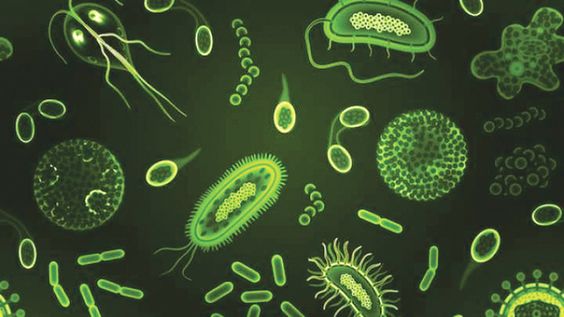A protozoan, or unicellular eukaryote, is a complete organism in which all life activities occur within the limits of a single plasma membrane. Unicellular eukaryotes are found wherever life exists. They are highly adaptable and easily distributed from place to place. They require moisture, whether they live in marine or freshwater habitats, soil, decaying organic matter, or plants and animals. They may be sessile or free swimming and they form a large part of the floating plankton. The same species are often found widely separated in time as well as in space. Some species may have spanned geological eras exceeding 100 million years. Despite their wide distribution, many protozoa can live successfully only within narrow environmental ranges. Species adaptations vary greatly, and successions of species frequently occur as environmental conditions change.
Protozoa play an enormous role in the economy of nature. Their fantastic numbers are attested by the gigantic ocean soil deposits formed over millions of years by their skeletons. About 10,000 species of unicellular eukaryotes are symbiotic in or on animals or plants, sometimes even other protozoa. The relationship may be mutualistic (both partners benefit), commensalistic (one partner benefits, no effect on the other), or parasitic (one partner benefits at the expense of the other), depending on the species involved. Parasitic forms cause some of the most important diseases of humans and domestic animals.
HOW DO WE DEFINE PROTOZOAN GROUPS?
For many years, all protozoans were placed within a single phylum comprised of eukaryotic unicells, but phylogenetic studies showed this group was not monophyletic. Evidence suggests that the origin of the first eukaryote was followed by great diversification, leading some biologists to predict that more than 60 monophyletic eukaryotic clades will eventually emerge. The well supported clade Opisthokonta includes unicellular choanoflagellates, multicellular animals (metazoans) and fungi, among others. Like the Opisthokonta, the clade Viridiplantae has both unicellular and multicellular members; this group contains green algae, the bryophytes, and the vascular plants. The remaining eukaryotic clades contain less well-known organisms, many of which were considered protozoans.
Protozoans and their relatives have been given several names. Protozoans are usually unicellular, so the name Protoctista was initiated to include unicellular and closely related multicellular organisms in one group. However, protoctistan is far less commonly used than the names protist and protozoan. Protist is a general term that does not distinguish between plantlike and animal-like unicells, whereas protozoan was intended for a subset of animal-like unicellular organisms.
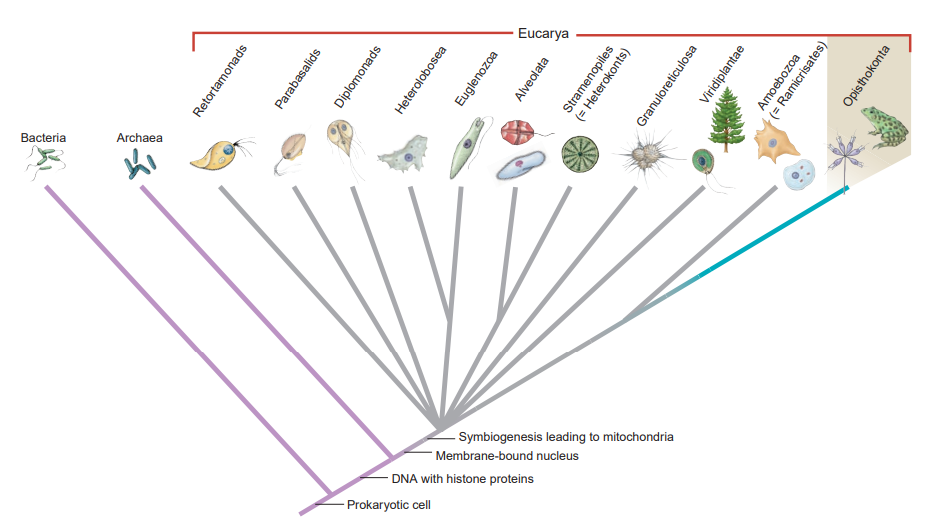
The two concepts, plantlike and animal-like, refer in part to the way that food is gathered. Plants are typically autotrophic, meaning that they synthesize their own organic constituents from inorganic substrates. Photosynthesis is one kind of autotrophy. Animals are typically heterotrophic, meaning that they obtain organic molecules synthesized by other organisms. Heterotrophic protozoa may ingest their food in a soluble form or in a particulate form. Particulate food is acquired by phagocytosis via an infolding or invagination of the cell membrane to surround a visible food particle. Heterotrophs that feed on visible particles are phagotrophs or holozoic feeders, whereas those that ingest soluble food are osmotrophs or saprozoic feeders.
A distinction between plants and animals on the basis of nutrition works well for multicellular forms, but the plant-animal distinction is not so clear among unicells. Autotrophic protozoa (phototrophs) use light energy to synthesize their organic molecules, but they often practice phagotrophy and osmotrophy as well. Even among heterotrophs, few are exclusively either phagotrophic or osmotrophic. A single class Euglenoidea contains some forms that are mainly phototrophs, some that are mainly osmotrophs, and some that are mainly phagotrophs. Species of Euglena show considerable variety in nutritional capability.
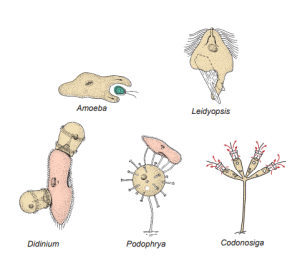
Some species require certain preformed organic molecules, even though they are autotrophs, and some lose their chloroplasts if maintained in darkness, thus becoming permanent osmotrophs. The mode of nutrition employed by unicellular organisms is opportunistic and highly variable, even within a single species, so nutritional features have proved unreliable for defining protozoans, or protozoan subgroups.
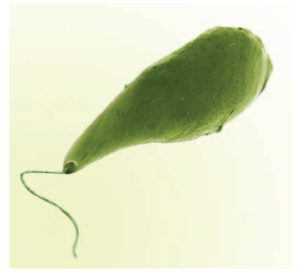
Originally, the means of locomotion was used to distinguish three of the four classes in the traditional phylum Protozoa. Members of a parasitic class, once called Sporozoa, lack a distinct locomotory structure, but share an organelle capable of invading host cells. Members of the other three traditional protozoan classes differ in means of locomotion: flagellates use flagella, ciliates travel via a ciliated body surface, and amebas extend their pseudopodia to move. Typically, a flagellate has a few long flagella, and a ciliate has many short cilia, but no real morphological distinction exists between cilia and flagella. Some investigators have preferred to call Amebas are able to assume a variety of body forms due to flowing cell cytoplasm. The cytoplasm can be extended outward in pseudopodia of various shapes: lobopodia are blunt-tipped, filipodia are thin and sharply pointed, rhizopodia are branched filaments and reticulopodia are branched filaments that merge to form a netlike structure. Axopodia are thin, pointed pseudopodia that contain a central longitudinal (axial) filament of microtubules.
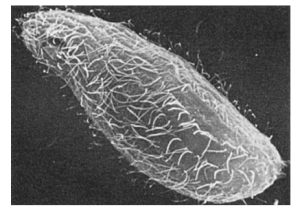
Amebas that make shells are called testate. Arcella and Difflugia have their delicate plasma membrane covered with a protective test or shell of secreted siliceous or chitinoid material that may be reinforced with grains of sand. They move by means of pseudopodia that project from openings in the shell. Some very abundant shelled amebas are known as foraminiferans (Globigerina) or radiolarians. The name heliozoan refers to freshwater amebas with axopodia; they may be testate or not. Amebas without shells are called naked.
The phylum Sarcomastigophora was divided into two subphyla: Sarcodina contained the amebas and Mastigophora contained the flagellates. Mastigophorans were distinguished as plantlike (Phytomastigophorea) or animal-like (Zoomastigophorea). Our previous discussion of feeding mode as a taxonomic character should lead the reader to suspect that the Mastigophora was not a monophyletic group. However, the names remain quite descriptive and one easily deciphers a phytomastigophoran as a flagellate with plastids.
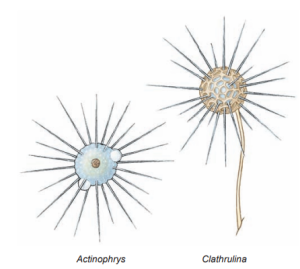
Molecular analyses, using sequences of bases in genes, particularly the gene encoding the small subunit of ribosomal RNA along with genes encoding some proteins, have revolutionized our concepts of phylogenetic affinities in protozoans, and indeed, all eukaryotes. The new clade names given to branches in a molecular phylogeny make it difficult for those already familiar with protozoan taxa to recognize group members, but retaining only the old names makes an informed reading of new research impossible. So, in the phylogenetic section at the end of this chapter, we retain the system of phyla outlined in comprehensive monographs such as Hausmann and Hülsmann (1996) and used in recent texts such as Roberts and Janovy (2005). However, we also use some recently erected clade names as we discuss particular protozoan groups.
Some traditional names do not represent monophyletic groups. Molecular analyses show that the ameboid body form has evolved independently several times, as has the shell. So animals called heliozoans are divided among five clades, and those called radiolarians are divided among three, according to some workers. Among the testate amebas, only foraminiferans appear to be a monophyletic group; they now belong in a clade called the Granuloreticulosa.
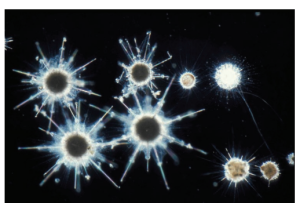
Despite the diversity of form, protozoans do demonstrate a basic body plan or grade—a single eukaryotic cell—and they amply demonstrate the enormous adaptive potential of that grade. Over 64,000 species have been named, and over half of these are fossils. Some workers estimate there may be 250,000 protozoan species. Although they are unicellular, protozoa are functionally complete organisms with many complicated, microanatomical structures. Their various organelles tend to be more specialized than those of the average cell in a multicellular organism. Particular organelles may perform as skeletons, sensory structures conducting mechanisms, and other functions. These organelles bear closer scrutiny because of their functional importance and because differences in organelle structure can provide homologous characters on which to base taxonomic categories.
Useful External Links
- PROTOZOA by MICROBIOLOGY SOCIETY
- Protozoa: Structure, Classification, Growth, and Development by National library of Medicine
- Have the Protozoa Been Overlooked? by BioScience

